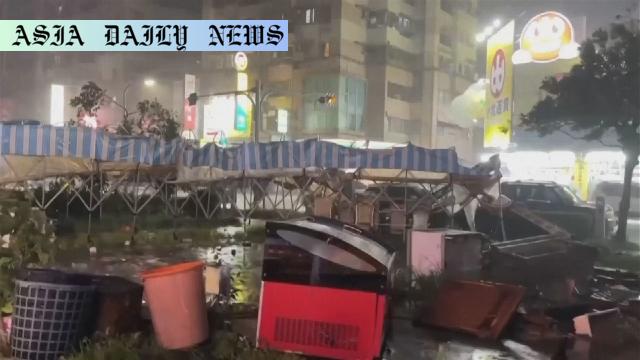Typhoon Danas: The storm caused significant destruction by claiming two lives and injuring over 300 people in Taiwan.
- Typhoon Danas caused significant destruction in Taiwan, leaving 2 dead and over 300 injured.
- The storm disrupted 138 flights, majorly impacting transportation in the region.
- Power outages and fallen trees contributed to fatalities and injuries.
- The storm moved through Taiwan before heading to the East China Sea.

Typhoon Danas Strikes Taiwan with Deadly Impact
On Sunday, Typhoon Danas unleashed its destructive force as it made landfall on Taiwan’s main island, delivering intense rain and strong winds. The storm, which reached Chiayi County in southern Taiwan late Sunday night, caused widespread destruction, leading to the tragic loss of two lives and causing injuries to over 300 individuals. The aftermath of the typhoon has left communities grappling with significant disruptions, including power outages and substantial damage to infrastructure.
The fatalities included a 69-year-old man whose vehicle was struck by a fallen tree in Tainan, and a 60-year-old patient who tragically lost his life after his ventilator stopped working during a power outage, also in Tainan. These incidents highlight the severe risks posed by natural disasters, particularly for vulnerable populations. Emergency responders have been working tirelessly to address the immediate aftermath, clearing debris and restoring essential services.
Widespread Injuries and Transportation Disruption
Authorities have reported that Typhoon Danas resulted in injuries to 334 people, with most of the incidents occurring in southern Taiwan. The storm’s extensive impact has led to the cancellation of 138 flights within Taiwan, nearly half of its daily flight operations. Additionally, multiple international flights, including routes to China, were also affected as the storm intensified. With roads blocked by fallen trees and debris, efforts are underway to restore normalcy to the region’s transportation network.
Ongoing Weather Concerns and Preparations for Recovery
Taiwanese weather authorities have warned that strong winds and rains are expected to persist until Monday night. Residents in affected areas have been urged to remain vigilant and take precautions to stay safe. Power outages in multiple locations have left some communities in darkness, further adding to the challenges posed by the typhoon. Efforts are currently focused on clearing roads, restoring power, and providing support to the injured and displaced individuals.
In addition to immediate emergency responses, authorities are also assessing the long-term impacts of the typhoon on the region’s infrastructure and economy. The intense winds and heavy downpours have caused significant damage to buildings, vehicles, and farmland, underscoring the need for comprehensive disaster preparedness and relief strategies in Taiwan’s storm-prone regions.
Lessons from Typhoon Danas
Typhoon Danas serves as a stark reminder of the vulnerabilities faced by island nations like Taiwan during the typhoon season. This event demonstrates the importance of preparedness, both at the individual and government levels. Strengthening infrastructure, ensuring reliable backup systems for medical equipment, and enhancing early warning systems are key steps that can mitigate losses in future disasters. While the country’s response teams have worked diligently to minimize harm, the scope of this storm demonstrates the ongoing need to adapt and prepare for increasingly severe weather events due to climate change.
As Taiwan continues its recovery efforts, the resilience and communal spirit of its people will undoubtedly play a crucial role in overcoming the challenges brought by Typhoon Danas. The government and local organizations will need to focus on providing long-term support to affected communities while taking steps to prepare for future events. With better planning, infrastructure improvements, and enhanced resilience measures, Taiwan can mitigate the impact of typhoons and weather-related disasters.



Commentary
The Grave Impact of Typhoon Danas
Typhoon Danas has once again highlighted the unpredictable and destructive nature of severe weather events. The storm, which made landfall in Taiwan, has left a tragic mark on the island, claiming two lives and injuring over 300 people. As the storm moved across the region, it not only caused personal loss but wreaked havoc on infrastructure and disrupted daily lives. This event stands as a sobering reminder of the vulnerability of communities to natural disasters.
Infrastructure and Systemic Vulnerabilities
The fatalities resulting from Typhoon Danas also bring to light systemic vulnerabilities that need urgent attention. For instance, the death of a 60-year-old patient due to a power failure and subsequent ventilator malfunction raises concerns about the resilience of medical systems during crises. Ensuring that essential systems and healthcare facilities have reliable backup power support is vital as storms of this magnitude become more frequent. Additionally, the widespread cancellation of flights and transportation disruptions demonstrate the severe logistical challenges posed by such disasters.
Adapting in the Face of Climate Change
The occurrence of Typhoon Danas and its aftermath should prompt serious discussions on climate change and disaster preparedness. Climate change has been linked to more intense and frequent storms, making it imperative for countries like Taiwan to not only strengthen physical infrastructure but also enhance early warning systems and community-based preparedness programs. Public education campaigns focusing on disaster readiness and response could go a long way in saving lives during emergencies like these.
Events like Typhoon Danas serve as a wake-up call, not only for Taiwan but for the global community. As extreme weather events become more common, the urgency to act, adapt, and invest in resilience is evident. We must learn from these disasters, honor those affected through proactive measures, and work tirelessly to ensure that future storms leave a less devastating impact.